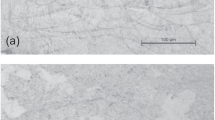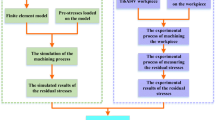Abstract
Residual stress (RS) has been intensively studied as an important criterion for evaluation of the surface integrity of high-speed machining (HSM) in this article. Based on the elastoplastic material property, a valuable machining property of gradient distribution of the machining path to the machined surface with HSM ball end milling is observed via an experimental test. Furthermore, an experimental formula is deduced from HSM ball end milling on H13 die steel. A cumulative coefficient for this effect is obtained by the residual stress measurement data. This is one method of predicting the residual stress concentration zone using the formula and coefficient to calculate the residual stress along the machining path. Based on the result, a discussion is presented in different fields of elastoplasticity metal material.
Similar content being viewed by others
References
Chen XX, Zhao J, Li Y, Han S, Cao Q, Li A (2012) Investigation on ball end milling of p20 die steel with cutter orientation. International Journal of Advanced Manufacturing Technology 59(9-12):885–898
Totten GE, Howes M, Inoue T (2002) Handbook of residual stress and deformation of steel. ASM International
Pisarev VS, Eleonsky SI, Chernov AV (2015) Residual stress determination in orthotropic composites by displacement measurements near through hole. Experimental Mechanics 55(7):1225–1238
Bert CW, Thompson GL (1968) A method for measuring planar residual stresses in rectangular orthotropic materials. Journal of Composite Materials 2(2):244–253
Baldi A (2014) Residual stress analysis of orthotropic materials using integrated digital image correlation. Experimental Mechanics 54(54):1279–1292
M’Saoubi R, Outeiro JC, Changeux B, Lebrun JL, Dias AM (1999) Residual stress analysis in orthogonal machining of standard and resulfurized aisi 316l steels. Journal of Materials Processing Technology 96(1–3):225–233
Jacobus K (2001) Predictive model for the full biaxial surface and subsurface residual stress profiles from turning. Canadian Geotechnical Journal 40(3):709–710 (2)
El-Axir MH (2002) A method of modeling residual stress distribution in turning for different materials.International. Journal of Machine Tools & Manufacture 42(9):1055–1063
Li JL, Jing LL, Chen M (2009) An FEM study on residual stresses induced by high-speed end-milling of hardened steel skd11.Journal of. Materials Processing Technology 209(9):4515–4520
Ding TC, Zhang S, Lv HG, Xu XL (2015) A comparative investigation on surface roughness and residual stress during end-milling AISI h13 steel with different geometrical inserts. Physical Review Special Topics Accelerators & Beams 18(8):1085–1093
Sasahara H, Obikawa T, Shirakashi T (1996) Fem analysis of cutting sequence effect on mechanical characteristics in machined layer. Journal of Materials Processing Technology 62(4):448–453
Guo YB, Anurag S, Jawahir IS (2009) A novel hybrid predictive model and validation of unique hook-shaped residual stress profiles in hard turning. CIRP Annals - Manufacturing Technology 58(1):81–84
Salahshoor M, Guo YB (2014) Finite element simulation and experimental validation of residual stresses in high speed dry milling of biodegradable mg-ca alloys. International Journal of Mechanical Sciences 80:281–286
Denkena B, Lucas A (2007) Biocompatible magnesium alloys as absorbable implant materials – adjusted surface and subsurface properties by machining processes. CIRP Annals - Manufacturing Technology 56(1):113–116
Li, Y (2009). Experimental study of cumulative effect of residual stress on machined surface on HSM. International Conference on Experimental Mechanics (Vol.7522, pp.75225Q-75225Q-10). Fourth International Conference on Experimental Mechanics
Cao QY (2011) Cutting force modeling considering cutter deflection for sculptured surface milling. International Journal of Manufacturing Technology & Management 22(4):362–375
Li YE, Zhao J, Wang W, Cao QY (2010) A mathematical model of EEBP for HSM surface quality prediction. Advanced Materials Research 97-101:2123–2127
Ahmadi K, Altintas Y (2013) Stability of lateral, torsional and axial vibrations in drilling. International Journal of Machine Tools & Manufacture 68(3):63–74
Altintas Y (2000) Modeling approaches and software for predicting the performance of milling operations at MAL-UBC. Machining Science & Technology 4(3):445–478
Rigelsford J (2004) Manufacturing automation: metal cutting mechanics, machine tool vibrations, and cnc design. Industrial Robot 31(1):B84
Ashby MF (1999) Materials selection in mechanical design / m.f. ashby. Lecture Notes in Mechanical Engineering 40(7):1–9
Akbar F, Mativenga PT, Sheikh MA (2010) An experimental and coupled thermo-mechanical finite element study of heat partition effects in machining. International Journal of Advanced Manufacturing Technology 46(5-8):491–507
Ganesh P, Kumar H, Kaul R, Kukreja LM (2013) Microstructural characterization of laser surface treated aisi 1040 steel with portable x-ray stress analyzer. Surface Engineering 29(8):600–607
Chen XX, Zhao J, Li YE, Han SG, Cao QY, Li AH (2011) Numerical modeling of high-speed ball end milling with cutter inclination angle. Part B J Eng Manuf. Proceedings of the Institution of Mechanical Engineers Part B Journal of Engineering Manufacture 226(4):606–616
Lua J, Zhang T, Fang E, Song JH (2015) Explicit phantom paired shell element approach for crack branching and impact damage prediction of aluminum structures. International Journal of Impact Engineering 87:28–43
Author information
Authors and Affiliations
Corresponding author
Rights and permissions
About this article
Cite this article
Li, Y., Zhang, H.H. & Zhao, J. A study of machined surface RS gradient distribution and cumulative on HSM ball end milling. Int J Adv Manuf Technol 91, 1431–1442 (2017). https://doi.org/10.1007/s00170-016-9712-z
Received:
Accepted:
Published:
Issue Date:
DOI: https://doi.org/10.1007/s00170-016-9712-z




